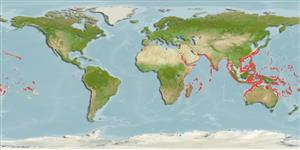Common names from other countries
分類 / Names
共通名の | 類義語 | Catalog of Fishes(部類, 種) | ITIS | CoL | WoRMS | Cloffa
Environment: milieu / climate zone / depth range / distribution range
生態学
海 関連する礁; 移住性ではない; 深さの範囲 80 - 370 m (Ref. 5222). Tropical; 31°N - 31°S, 30°E - 134°W (Ref. 5222)
Indo-Pacific: Red Sea and East Africa to the central Pacific. Epinephelus poecilonotus, Epinephelus radiatus, and Epinephelus tuamotoensis are sometimes referred to as this species.
サイズ / 重さ / 年齢
Maturity: Lm ? range ? - ? cm
Max length : 90.0 cm TL オス/雌雄の選別がない; (Ref. 2871); common length : 60.0 cm TL オス/雌雄の選別がない; (Ref. 9137); 最大公表体重: 6.7 kg (Ref. 40637)
背面の脊椎 (合計) : 11; 背鰭 (合計) : 14 - 15; 肛門の骨: 3; 臀鰭: 7 - 8. Distinguished by the following characteristics: head and body tan, with dark brown bands: bifurcate band that begins at rear edge of eye, upper branch extending to a dark brown saddle blotch on the nape just in front of dorsal fin, lower branch running to lower opercular spine and continuing on body as midlateral band that bifurcates above the pectoral fin, upper branch of this band running to a dark blotch at the base of 3rd to 7th dorsal fin rays; dark band from the upper edge of the operculum to base of 5th to 9th dorsal fin spines; narrow band from lower edge of eye to pectoral fin base, continued as broken band along lower part of body and curving up to the dorsal part of peduncle; broad band from maxillary groove to posterior end of interopercle; small dark brown spots often present in the pale areas between bands; depth of body contained 2.8-3.1 times in SL; head length 2.3-2.5 times in SL; flat to moderately convex interorbital area, dorsal head profile slightly convex; shallow indentation on preopercle just above the enlarged serrae at the angle; upper edge of operculum almost straight; maxilla reaches to or past vertical at rear edge of eye; 2 rows of teeth on midlateral part of lower jaw (Ref. 89707).
Found in deep waters from 80-370 m on slopes of islands, sea mounts or continental shelves. Feeds on benthic fishes and large invertebrates (Ref. 89707). Considered rare in Tahiti but quite common in atolls (Ref. 4821). The species is easily confused with E. poecilonotus, E. radiatus, or E. tuamotuensis, three closely related deep-water groupers. Known to be ciguatoxic at Mauritius. Uncommon in local markets (probably due to it deep-water habitat).
Life cycle and mating behavior
Maturities | 繁殖 | Spawnings | Egg(s) | Fecundities | 幼生
Heemstra, P.C. and J.E. Randall, 1993. FAO Species Catalogue. Vol. 16. Groupers of the world (family Serranidae, subfamily Epinephelinae). An annotated and illustrated catalogue of the grouper, rockcod, hind, coral grouper and lyretail species known to date. Rome: FAO. FAO Fish. Synop. 125(16):382 p. (Ref. 5222)
CITES (Ref. 128078)
Not Evaluated
人間に対する脅威
Reports of ciguatera poisoning (Ref. 5222)
Human uses
水産業: 少数商業の; ゲームフィッシュ: はい
用具
特記事項
XMLをダウンロードして下さい
インターネットの情報源
Estimates based on models
Preferred temperature (Ref.
115969): 14.2 - 23.1, mean 19 (based on 305 cells).
Phylogenetic diversity index (Ref.
82804): PD
50 = 0.5000 [Uniqueness, from 0.5 = low to 2.0 = high].
Bayesian length-weight: a=0.01318 (0.00806 - 0.02156), b=3.03 (2.90 - 3.16), in cm Total Length, based on LWR estimates for this species & Genus-body shape (Ref.
93245).
栄養段階 (Ref.
69278): 4.0 ±0.65 se; based on food items.
回復力 (Ref.
120179): 手段, 1.4年~4.4年の倍増期間の最小個体群 (Preliminary K or Fecundity.).
Fishing Vulnerability (Ref.
59153): Moderate vulnerability (43 of 100).
Climate Vulnerability (Ref.
125649): Very high vulnerability (86 of 100).
